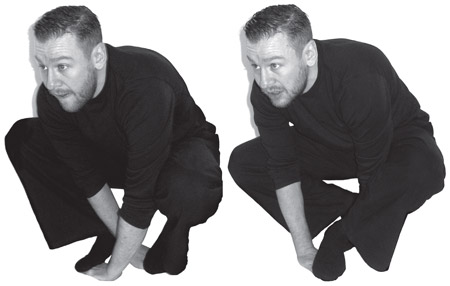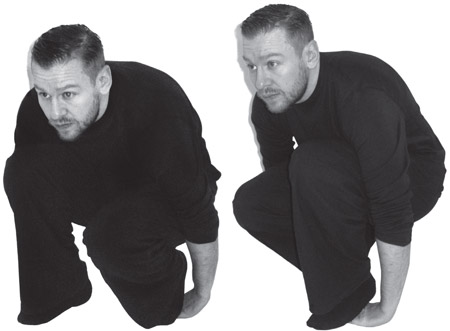Read In Search of the Niinja Online
Authors: Antony Cummins
In Search of the Niinja (29 page)
The following problem is caused by researchers and ninjutsu practitioners mixing up two separate and special ways of walking.
The ‘Deep Grass Rabbit Step’ is famous in the world of ninjutsu and poses the largest problem. In modern times
87
it have been interpreted as a form of silent walking, where a ninja places his hands underneath each respective foot, left hand under left foot and right hand under right foot, at which point the ninja in a couched position, shuffles forward. A similar form of this crouched walk exists in the
Shinobi Hiden
but in this version a ninja alternates his steps, placing his left foot on his right hand and then moving forward and placing his right foot on his left hand. He crouches and moves forward placing each hand forward and then stepping on it with the opposite foot. However, this is
not
called ‘Rabbit Stepping’ in the
Shinobi Hiden
manual and there was no association with the ‘Rabbit Step’ until the researcher Yumio Nawa
made an unfounded connection in the twentieth century.

The opposite hand on opposite foot original version in the
Shinobi Hiden
manual by Hattori Hanzo, 1560.
The original description of the unnamed walk in the
Shinobi Hiden
manual states: ‘Place your left hand [forward] and then place your right foot on it and then put down your left hand and put your left foot on it.’ As can be seen there is a transcription error here as the walk would be impossible. There is a strange use of two versions of the ideogram for left – this use of alternative ideograms and the flow of the original writing has led the Historical Ninjutsu Research Team to conclude that the original walk was opposite hand to opposite foot (but the same hand same foot method has not been discarded), making the translation as follows: ‘Place your left hand [forward] and then place your right foot on it and then put down your right hand and put your left foot on it.’

The same unnamed step which occurs in the much later and changed version of the
Shinobi Hiden
manual in the Nagata family (1843), which is now the popular and probably incorrect version misnamed the Rabbit Step.
The later nineteenth-century
Nagata
transcription of the
Shinobi Hiden
manual changes the method of the unnamed walk, from the above to the same hand/same foot method. This is a change 250 years after the event.
Returning to the ‘Rabbit Step’ in the
Bansenshukai
and the modern idea that a ninja steps on each respective hand, it is
possible
that this skill of walking on same hand same foot is authentic, however the
Bansenshukai
itself never explains how to perform the ‘Rabbit Steps’, it simply states that a ninja should use
Shinso no Uho
88
Jutsu
which translates as ‘the art of regular or make shift Uho-rabbit steps’. His instructions also state that a ninja should use these steps (including the use of the cotton padded silent sandals) like a ‘leaf floating on water’, i.e. the foot does not leave the ground, it ‘floats’ along in a sliding pattern. The now modern form of standing on the respective hands is never shown with this ‘floating’ movement and is usually done in a form of short stepping or shuffling motion, where the foot leaves the floor.
89
The Rabbit Step so named in the
Bansenshukai
and the Unnamed Step in the
Shinobi Hiden
appear to have been mixed together by modern researchers incorrectly.
Alternatively, I and team mate Yoshie Minami favour another method which can be found documented, a step called ‘
Uho
’ (sometimes
‘Ufu’
) which exists outside of ninjutsu documentation.
This
Uho
step is found in the Chinese ritual ‘magic’ art of
Omyodo
where the
Uho
90
(
Henbai
) or ‘Emperor’s Step’ is used in ritual ceremonies in Japan. One steps and slides one foot forward, doing the same with the alternate foot and bringing the feet together, side by side as each step continues. Slide forward with the left, then bring the right foot to meet it, then slide forward with the right foot and bring the left to meet it so that they are side by side again, akin to skating.
The name of both the Chinese magical step and the
Bansenshukai
step can be read as
Uho:
 –
–
Uho
or the ‘U’ dynasty step (meaning the Emperor of)
 –
–
Uho
rabbit step taken from the
Bansenshukai
It is possible that Fujibayashi is referring to this ‘ritual’ step and that his instructions about doing it ‘like a leaf on water’ is an instruction to not raise the foot. The step itself is named after a Chinese Emperor of the dynasty and as is often found in Japanese manuals, an ideogram is chosen for its phonetic sound and not its meaning. This step with the sound of
dynasty and as is often found in Japanese manuals, an ideogram is chosen for its phonetic sound and not its meaning. This step with the sound of
Uho
would have been understood by Fujibayashi
’s
contemporaries and the phonetic use would not have been an issue, which may be why he never describes its actual method. It must be remembered that often in the
Bansenshukai
alternative ideograms are used simply for their sound and not their meaning. To further support this theory of the sliding side-by-side step we can see that the
Shoninki
manual shares some of the ‘ninja’ steps used in the
Bansenshukai
and also that the
Shoninki
uses the
Suriashi
step, a form of ‘sliding’ step. To further associate this
Uho
step with the
Suriashi
or sliding step we can turn to the document
Sho Henbai Saho Narabini Goshinho
written in 1154 by the Wakasugi clan, who served the
Tsuchimikado
clan. The Tsuchimikados were the official head family of the Chinese art of
Onmyodo
and approved by the imperial court. According to this document, the
Uho
or
Ufu
step is as follows:
Whilst chanting the nine stars of the
Tonko Shikisen
, step forward from with left foot with the Suriashi sliding step and continue as follows:
Left foot chant | ‘Tenpo’ |
Right foot chant | ‘Tendai’ |
Left foot | ‘Tensho’ |
Right foot | ‘Tenpo’ |
Left foot | ‘Tenkin’ |
Right foot | ‘Tenshin’ |
Left foot | ‘Tenchu’ |
Right foot | ‘Tennin’ |
Left foot | ‘Tenei’ |
The
Uho
step performed like a leaf on water in the
Bansenshukai
may actually be a variation on the
Suriashi
or sliding step. And whilst it seems likely, there is no mention of chanting the name of the stars whilst infiltrating, which is maybe why Fujibayashi says perform a ‘modified’ version.
The prefix to the word
Uho
is the word
Shinso
. If all the above mistakes by Japanese researchers were not enough to cause trouble, then this final section is the nail in the coffin. People in the past translated the term
Shinso no Toho (Uho) to mean ‘Deep Grass Rabbit Step’, which is a problem, because the
to mean ‘Deep Grass Rabbit Step’, which is a problem, because the
Bansenshukai
never says this. The
Bansenshukai
says which translates as ‘use normal or make shift
which translates as ‘use normal or make shift
Uho
steps’ The term ‘Deep Grass’ was added in the twentieth century, because the researchers at the time did not understand that the term ‘
Shinso
’ meant modified steps. Fujibayshi does use this word in other parts of the
Bansenshukai
to mean ‘use the original or the modified version’. In summary, using the original manual only, the art of the
Uho
step is a form of sliding
Suriashi
walk, a sliding step to move silently down corridors.
